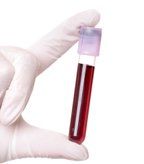Blood Tests for Early Detection of Breast Cancer and Treatment Monitoring
New technologies and techniques are in development to use blood samples to detect biological material in the blood that can differentiate a patient with cancer from one who does not have cancer and to aid in the treatment of breast cancer patients.
Today at the 30th annual Miami Breast Cancer Conference, Emanuel F. Petricoin III, PhD discussed the development of new blood-based tests for both the treatment and early detection of breast cancer in his presentation, “The Use of Blood Tests in Breast Cancer for Early Detection and Treatment.” New technologies and techniques are in development to use blood samples to detect biological material in the blood that can differentiate a patient with cancer from one who does not have cancer.

Many new research initiatives to identify biomarkers and translate these into the clinic are underway. For example, the Early Detection Research Network (EDRN), part of the National Cancer Institute (NCI) is coordinating biomarker identification studies at various institutions, both for breast cancer screening and breast cancer testing.
“What we are seeing now is a confluence of new technologies being developed and implemented both for discovering biomarkers in the serum, blood, and other body fluids (such as nipple fluid aspirates) for breast cancer diagnosis and tracking,” said Petricoin. There are also new nanotechnologies and nanoparticles that can be added to blood samples for detection of specific biomarkers, according to Petricoin.
The specific biomarkers for breast cancer are not just proteins but also DNA and RNA, for both detection and for monitoring therapeutic efficacy of treatments in breast cancer patients.
Blood tests for early diagnosis, as well as tracking therapeutic efficacy aim are seen as a potential way to assess the biology of a tumor noninvasively. There are also nipple fluid profiling approaches, which could be a direct way to analyze what is going on in the breast, again in a noninvasive way.
One current approach Petricoin highlighted is the development of a blood test based on unique glycoproteins identified by mass spectrometry analysis of breast tumors. The premise is that breast tumor–unique proteins end up in the blood and can be found with a simple blood draw.
A major question for development of a biomarker for breast cancer is timing-when would a test be most useful? For now, biomarkers are being explored at all stages, from screening to advanced stage recurrence. “All of these stages are where biomarkers could be useful,” said Petricoin. At the screening stage, some biomarkers may be useful for testing high-risk patients, prior to or after mammography screening. For example, a biomarker could provide further information on whether a patient with a positive mammogram needs a follow-up biopsy, reducing the number of unnecessary biopsies in patients with benign masses.
In the context of disease monitoring, biomarkers will likely serve a role in both assessment of recurrence, including tracking the type of molecular resistance, as well as monitoring tumor shrinkage or other type of therapeutic response. Treatment biomarkers that are in development include HER2, HSP90, and Ki67.
Most blood-based biomarkers are still in early development. Particularly, Petricoin noted that blood tests for tumor response and prognosis are in early stages. These include cancer stem cells and tumor-specific DNA. “We are expanding beyond just traditional proteins to see if we can accurately detect circulating tumor cells that can be shed from a tumor and detected in the blood of cancer patients,” said Petricoin.
There are both biomarkers that can be detected using existing technology and those that require new platforms and technologies to measure. Many of these markers are measured by quantitative mass spectrometry, according to Petricoin. One of the new ways to do mass spectrometry is through multiple reaction monitoring (MRM). “MRM assays are on the cutting edge. There is a lot of potential and hope and also a lot of hype in the oncology community,” said Petricoin. MRM is particularly promising because the approach does not require antibodies to detect protein markers and measurement analysis is rapid. Currently, MRM is used to detect molecules such as testosterone or illegal drugs in bodily fluids, but their use for protein detection is novel.
In combination with traditionally used imaging modalities such as mammography, MRI, and ultrasound, new tests could also improve early detection and lower false-positive diagnosis rates. To improve breast cancer outcomes, biomarkers tools also aim to facilitate tracking of treatment responses to understand early on in the course of therapy whether a treatment is efficacious.